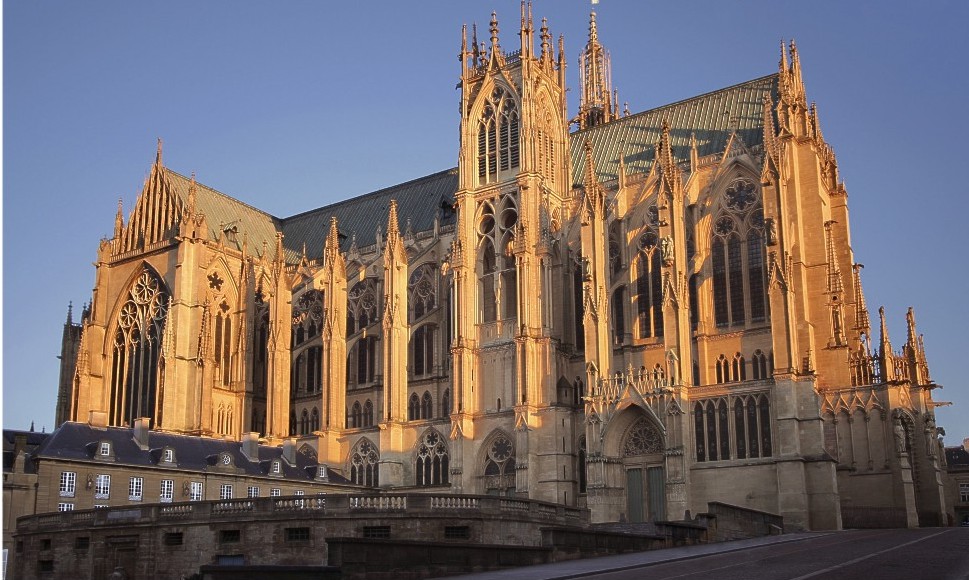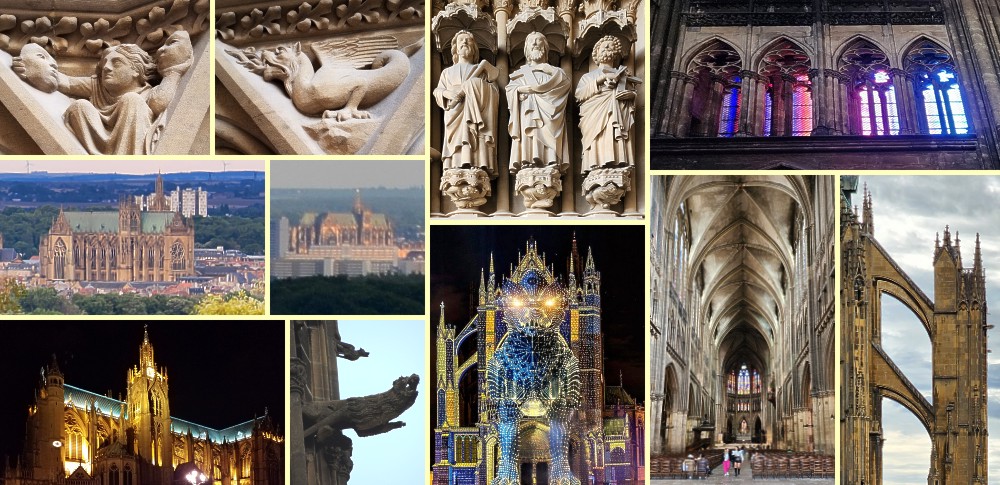
Kansas Snapshots by Gloria Freeland - September 22, 2023

St. Etienne
"God's Lantern" breathes
In our travels, husband Art and I have been fortunate to visit a number of grand Gothic cathedrals - Paris's Notre Dame, London's
Westminster Abbey, and the York Minster, to name a few. But the magnificent St. Étienne Cathedral in Metz, France was the one
that captivated me from the first moment I saw it in 2014. It dominates the landscape like none of the others and has a number
of features they don't.
Over the years, we've seen it "come alive" during concerts inside and laser light shows projected outside on its southwest facade
on warm summer nights. Only St. Étienne impressed Art enough that he wrote a "treatise" about it, focusing on
the mathematics and mechanics of the building's impressive catenary arches and flying buttresses.
In 1220, Pope Honorius III gave the Metz bishop permission to raise money for a new church. It took years for the first stone to
be laid, and three centuries passed before construction was considered complete. Various events - logistical challenges, the War
of Metz, a siege in the 1320s, economic downturns, and the Black Plague, among others - caused delays.
During our various visits, I've photographed St. Étienne (St. Stephen in English) from many angles at different times of the day
and night, and I always see something different among its gargoyles, intricately-carved Biblical images, ornate wood figures,
and stained-glass windows. While most Gothic cathedrals are gray and "feel" emotionally cold, St. Étienne's honey-hued exterior
has warmth. The color is created by the oxidized iron in the locally-quarried Jaumont limestone. Obtained in nearby
Malancourt-la-Montagne, the word is a contraction of "jaune" and "montagne" - meaning "yellow mountain."
The cathedral has many hallmarks of Gothic architecture - ribbed vaults, an ornate pointed spire, and gargoyles that channel
rainwater away from its walls. But in many ways, it's unique.
The 140-foot high nave is one of the tallest in the world. The church isn't oriented on the traditional west-east axis, perhaps
because of the steep hill on one side. It was also designed to preserve structures already on the site, including an existing
church. At the time of the Pope's approval for the building, a round-shaped church called Notre-Dame-la-Ronde stood on the site.
The cathedral's plans were adjusted to blend the two.
But the church has been nicknamed "Lanterne du Bon Dieu" - God's Lantern - for good reason. It has 70,000 square feet of stained
glass - considered to be one of the largest expanses in the world. When night approaches, the light inside flows out through those
stained-glass panels and the cathedral literally glows.
When I sent photos of some of the windows to my brother Dave and sister Gaila, she asked which one was my favorite. I told her
that was difficult because they're all so beautiful. I did tell her I was partial to one that looked like it had incorporated a
sunflower.
A Gothic church is most likely to create a feeling of constancy over great spans of time. But this is another area where St.
Étienne is somewhat special. Although considered complete in about 1520, it has continued to evolve with prevailing tastes
of the day.
This is illustrated most clearly in its variety of stained-glass windows. Through the years, the church has commissioned artists
spanning eras and styles to create new ones. The "rose window" was crafted by one of the 14th century’s most famous glassmakers,
Hermann von Münster. Renaissance artist Valentin Bousch and Romanticist Charles-Laurent Maréchal also contributed windows. Others
were designed by late-19th-century Cubist Jacques Villon and mid-20th century Modernist Marc Chagall.
The tradition of adding new ones continues. One year ago, the window installation of South Korean artist Kimsooja (kim-soo-ja)
was inaugurated as part of the cathedral's 800th anniversary celebration. Titled "To Breathe," it was the first by a non-European
and and the first by a woman.
She transformed 16 existing windows utilizing the traditional Korean Obangsaek color spectrum. "O-bang" means "five directions"
and "Saek" means "color."
She collaborated with French glassmaker Pierre-Alain Parot to include two types of glass - traditional blown glass and dichroic
industrial glass. The latter contains metal oxides that produce changing colors as the angle of view or light incidence changes.
The windows' appearance shifts depending on the time of the day and the season of the year.
The new windows and laser light shows are just two of the recent ways the cathedral has re-created itself over eight centuries.
In my July 21, 2017 column, "Balancing the familiar with the unexpected," I described how the light show made the cathedral come
alive:
... At one point, it was seemingly wrapped in silk. At another, it appeared to crumble stone by stone as a laser "knife" cut
through it. At still another, it was being reconstructed in Lego form.
At other times, the cathedral became a living, breathing thing with brilliant reds, greens, golds and purples projected onto its
face, while thunderous music played. ...
While all of the famous Gothic churches have a grand and imposing feel about them, St. Étienne seems more like a family elder than a relic of long ago. And Kimsooja's installation is just one example of how art literally continues "To Breathe" new life into this ancient magnificent structure.

Top-1, 2, and 3 from left: examples of the cathedral's sculptures; right: Kimsooja's windows. Variation in color with light and viewing angle can be seen. Middle: How the cathedral dominates the skyline can be seen from 3 miles southwest (left) and 7 miles northwest (right) of Metz. Bottom (l-r): God's Lantern at night; a gargoyle; projection of dragon on cathedral's main entrance during summer light show; great height of ceiling may be judged compared to visitors below; two flying buttresses on end opposite the main entrance.
Comments? [email protected].
Other columns from this year may be found at: Current year Index.
Links to previous years are on the home page: Home